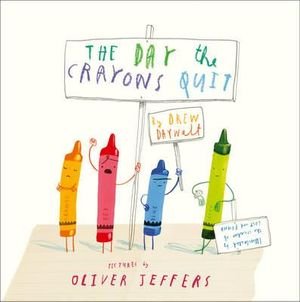Children's literature series - The day the crayons quit
The Day the Crayons Quit
By: Drew Daywalt, Oliver Jeffers (Illustrator)

(source: booktopia.com.au)
The text for this book is written in letter format. Various crayons belonging to Duncan write letters to him to let him know that his behaviour is affecting the way they feel. That’s right, a key theme for this text is ... EMPATHY. Yay! Such a difficult behaviour to teach to young children. Essentially, the crayons’ feelings can be grouped into three main areas: they are tired because Duncan has used them too much; they feel neglected because Duncan does not use them enough; they feel content because Duncan uses them enough to keep them happy and motivated. Of course some of the crayons experience emotions other than these (for example peach crayons who feels embarrassed because he lost his wrapper and is now naked!). This book is very popular with children 6-9 and thus is a great hook for a range of teaching and learning experiences (especially writing) and I really enjoy using it in the classroom.
How have I used this book in the classroom?
English
Reading (classifying)
- Feelings - TASK: group the crayons’ feelings in to three main areas- positive, negative and neutral
- Language - Select adjectives from each crayon’s letter that represent these feelings. TASK: sort these adjectives into positive, negative and neutral
Writing
- Cause and effect - create sentence stems to support students in writing sentences to explain cause and effect. For example, ‘Red crayon feels ________ because _____________’ —> Red crayon feels tired because Duncan uses him so much to colour Santas at Christmas, love hearts for Valentine’s Day and other things like fire engines and apples. TASK: write cause and effect sentences for a number of crayons within the text (scaffold according to students’ abilities).
- Persuasive - building upon the cause and effect learning, students are to compose a short persuasive text using the OREO (state opinion, give three pairs of reasons with examples, restate opinion) model for persuasive writing. TASK: write a letter to Duncan from you to persuade him to change his behaviour. You must give at least three reasons (each with examples) to support your argument.
- Perspective - TASK: write a letter from Duncan in response to one of the crayons’ letters. Students need to think about what Duncan might have changed after reading the crayon’s letter. TASK: write a letter from a stationery item in the classroom that is commonly ‘mistreated’. Students need to think about various ways in which the item is misused. For example, a whiteboard marker often has its lid not put on properly or is not put back in its place. These examples should be used to justify the item’s feelings.
Visual arts
At the end of the text, Duncan is shown to have changed his behaviour as a result of the crayons’ feedback by producing a colourful drawing in which he has used all of his crayons equally (and thus fairly). He has also drawn objects in unusual colours (for example, a green monkey and an orange whale). TASK: students are to create an artwork of their choice using crayons, with an equal and fair representation of a wide range of colours, and objects coloured differently to how they are usually represented.
UPDATE: 190302
Congratulations @mrhill! You have completed the following achievement on the Steem blockchain and have been rewarded with new badge(s) :
Click here to view your Board
If you no longer want to receive notifications, reply to this comment with the word
STOP